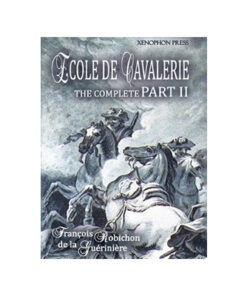The Art of Horsemanship by Xenophon
$24.95
8 in stock
Product Description
Xenophon’s The Art of Horsemanship is the earliest known work on the horse and how to ride it. Though Xenophon wrote his treatise twenty-three centuries ago, it still provides the modern-day equestrian enthusiast with much food for thought and is delightfully easy to read.
In this translation by Morris H. Morgan, Ph.D., there are chapters on the Greek Riding-Horse and Points of the Horse, with Notes on Xenophon’s text. Illustrated throughout with numerous photographs and line drawings, carefully chosen by Professor Morgan for their usefulness in explaining the various subjects treated in the text.
(softcover, photos, illustrations, 87 pgs.)
Excerpt from the book:
It has been my fortune to spend a great deal of time in rider, and so I think myself versed in the horseman’s art. This makes me willing to set forth to the younger of my friends what I believe would be the best way for them to deal with horses. It is true that a book on horsemanship has already been written by Simon; I mean the man who dedicated the bronze horse that the Eleusinion in Athens with his own exploits in relief on the pedestal. Still, I shall not strike out of my work all the points in which I chance to agree with him, but shall take much greater pleasure in passing them on to my friends, believing that I speak with the more authority because a famous horseman, such as he, has thought as I do. And then, again, I shall try to make clear whatever he has omitted.
To begin with, I shall describe how a man, in buying a horse, would be least likely to be cheated. In the case of an unbroken colt, of course his frame is what you must test; as for spirit, no very sure signs of that are offered by an animal that has never been mounted. And in his frame, the fist things which I say you ought to look at are his feet. Just as a house would be good for nothing if it were handsome above but lacked the proper foundations, so too a war-horse, even if all his other points were fine, would yet be good for nothing if he had bad feet; for he could not use a single one of his fine points.
2 reviews for The Art of Horsemanship by Xenophon
You must be logged in to post a review.
Related products
-

Vaqueros and Buckeroos by A.R. Rojas – third edition
0 out of 5$25.00Brands:Alamar Media Inc.Add to cart -

Lore of the California Vaquero by A.R. Rojas
5.00 out of 5$20.00Brands:Alamar Media Inc.Add to cart -

Bits, Bitting and Spanish Horses by A.R. Rojas
5.00 out of 5$20.00Brands:Alamar Media Inc.Add to cart -

The Horse: A Galloping History of Humanity by Timothy C. Winegard
0 out of 5$35.00 Add to cart -

Ecole de Cavalerie Part II – Expanded
0 out of 5$34.95 Read more




Nona Perez –
I have enjoyed this book for many years. It is interesting to read about horsemanship from the perspective of a fourth century BC Greek soldier who counted on his war horse for his success and survival. He discusses stabling, feeding, grooming, the humane treatment of the horse, and some advice for riding into battle. He advocated for gentle treatment of horses and training for understanding, not through force or fear. He states, “For what the horse does under compulsion… is done without understanding; and there is no beauty in it either, any more than one should whip and spur a dancer.”
As a student of horsemanship, I think one’s library is incomplete if this book is not in it.
windsongstablesharvardma –
As one of the earliest known recordings of horse training this is a staple in my library. Helps understand the early roots of methodology and philosophy that so many other s have leveraged, built upon and modernize for the form and function of the time in history.